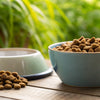Can You Give Puppies Wet Dog Food? A Comprehensive Guide for New Puppy Parents
- Houndsy
Table of Contents
- Introduction
- The Role of Wet Dog Food in a Puppy's Diet
- Benefits of Giving Puppies Wet Dog Food
- Drawbacks of Wet Dog Food
- At What Age Can Puppies Start Eating Wet Dog Food?
- How to Introduce Wet Food to Your Puppy
- What to Look for in Quality Wet Puppy Food
- Feeding Frequency and Quantity
- Conclusion
Introduction
Did you know that a puppy's diet can significantly impact their growth and development? In fact, the right nutrition sets the foundation for their health—from strong bones and teeth to healthy muscles and a robust immune system. As new puppy owners, we want to provide the best for our furry companions, and one of the most common questions is: can you give puppies wet dog food?
Understanding the benefits and potential drawbacks of wet food is essential for making informed choices about our pups' diets. With the myriad of options available, it’s easy to feel overwhelmed. This blog post aims to clarify the role of wet dog food in a puppy's diet, discuss its benefits and drawbacks, and provide practical tips for introducing it effectively.
By the end, you'll have a deeper understanding of whether wet food is suitable for your puppy and how to make feeding time a delightful experience for both of you.
The Role of Wet Dog Food in a Puppy's Diet
Wet dog food plays a unique role in a puppy's diet, primarily due to its texture and moisture content. As puppies transition from nursing to solid foods, wet food often serves as a gentle introduction to this new phase. Puppies have small, tender teeth that may struggle with harder kibble, making wet food an attractive and manageable choice.
Some key points to consider about wet food in a puppy's diet include:
- Hydration: With moisture content ranging from 60% to 80%, wet food provides additional hydration, which can be particularly beneficial for growing puppies who may not drink enough water.
- Palatability: The aroma and taste of wet food are more appealing to many puppies, making it an excellent option for picky eaters or those adjusting to their new home.
- Nutritional Value: Quality wet dog foods are formulated to meet the specific nutritional needs of growing puppies, supporting their development through balanced ingredients.
Benefits of Giving Puppies Wet Dog Food
-
Ease of Eating: Wet food is soft and easy to chew, making it suitable for puppies who are just beginning to develop their teeth. This ensures a pleasant eating experience without discomfort.
-
High Moisture Content: As mentioned earlier, the increased moisture content helps keep puppies well-hydrated. This is particularly valuable for puppies that may not drink enough water on their own.
-
Enhanced Flavor and Smell: Puppies tend to be more attracted to the strong aroma of wet food compared to dry kibble. This can be especially helpful in enticing fussy eaters to consume their meals.
-
Supports Weight Management: For puppies prone to overeating, wet food can help manage their calorie intake. It provides satisfying meals due to its moisture, making puppies feel full without excessive calories.
-
Flexible Feeding Options: Wet dog food can be mixed with dry kibble to create a delightful and nutritious meal, allowing us to customize our puppy's diet according to their preferences.
Drawbacks of Wet Dog Food
While wet dog food comes with numerous benefits, it also has potential drawbacks that we should consider as responsible pet parents.
-
Dental Health Concerns: Wet food does not promote any natural chewing action that can help clean teeth. This can lead to an increased risk of plaque and tartar build-up. Regular dental care remains essential for puppies on wet food.
-
Cost Considerations: Wet dog food can be more expensive than dry kibble. Depending on the brand and formulation, we may need to budget accordingly for consistent purchases.
-
Shorter Shelf Life: Once opened, wet food has a shorter shelf life compared to dry dog food. We should ensure proper storage and consume it within a set timeframe to prevent spoilage.
-
Messy Feeding: Wet food can be messier to serve and store than dry kibble. We may need to invest in more cleaning supplies or select feeding surfaces that are easy to clean.
-
Not Shelf-Stable: Unopened wet food has a longer shelf life than opened, but it still doesn't last as long as dry food. This can be less convenient for those who prefer to buy in bulk.
At What Age Can Puppies Start Eating Wet Dog Food?
Wet food can be introduced to puppies as early as three to four weeks of age during the weaning process. During this stage, they are transitioning from their mother’s milk to solid food. Here’s a brief timeline for introducing wet food:
- 3-4 weeks: Start introducing a mixture of wet food with milk replacer to create a gruel-like consistency, which is easy for the puppies to consume.
- 6-8 weeks: Puppies may be fully transitioned to solid foods, including wet dog food. At this point, they should be primarily eating soft foods.
For puppies already weaned when they come to live with us, we can introduce wet food at any time. Just remember to mix it with their current diet gradually to avoid upsetting their stomach.
How to Introduce Wet Food to Your Puppy
Transitioning our puppies to a new type of food, particularly wet food, should be done gradually. This helps their digestive system adjust while minimizing the chances of an upset stomach. Below are actionable steps to introduce wet food safely and effectively:
-
Choose High-Quality Wet Food: Opt for a reputable brand specifically formulated for puppies. The ingredients should include high-quality protein and essential nutrients.
-
Mix Gradually: Start by mixing a small amount of wet food into their current dry food. This blend allows them to become familiar with the new texture and taste.
-
Monitor Reactions: Observe your puppy for any signs of allergies or digestive issues during the transition period. If any concerns arise, consult your veterinarian.
-
Keep It Interesting: Enhance meal times by rotating different flavors of wet food to keep your puppy engaged and excited about eating.
-
Establish Routine: Set consistent feeding times to instill a sense of reliability and structure in your puppy’s eating schedule.
-
Positive Reinforcement: Always encourage your puppy with affection and excitement during meal times. This helps create a positive association with their food.
What to Look for in Quality Wet Puppy Food
When selecting wet puppy food, we should look for high-quality options to ensure our pups get the nutrients they need. Key factors to consider include:
- Complete and Balanced Nutrition: The food should meet the standards set by the Association of American Feed Control Officials (AAFCO) for growth and reproduction.
- Real Ingredients: Look for identifiable sources of protein (e.g., chicken, beef, or fish) rather than fillers or by-products.
- No Artificial Additives: Quality brands will avoid artificial preservatives, colors, or flavors, offering only wholesome ingredients.
- Nutritional Labeling: Review the ingredient list and guaranteed analysis panel to understand the nutrient profile, focusing on protein, fat, and moisture content.
Selecting high-quality wet food sets the stage for our puppies' health, and it’s essential to prioritize their dietary needs to ensure they grow up strong and healthy.
Feeding Frequency and Quantity
How often and how much we feed our puppies can vary based on their age, size, and energy levels. Here are some guidelines:
-
Up to 3 months: Puppies require four meals a day since their small stomachs can only hold a limited amount of food at once.
-
3 to 6 months: As they grow, reducing their meals to three times a day is usually appropriate.
-
6 months to 1 year: Transition to two meals a day, provided they have developed enough to handle larger portions.
To determine the right portion sizes, always refer to the feeding guidelines on the food packaging and consult with our veterinarian to address any specific dietary needs.
Conclusion
Navigating the world of puppy nutrition can seem daunting, but understanding the role of wet dog food makes it manageable. As we’ve explored, wet food can be a beneficial addition to our puppies' diets, providing hydration, palatability, and ease of eating. While there are some drawbacks, a thoughtfully balanced diet—incorporating both wet and dry food—can cater to our puppies’ growth needs.
As devoted pet parents, we want to ensure that our furry friends receive all the nutrients required for healthy development. By selecting high-quality wet food, introducing it gradually, and maintaining a sensible feeding routine, we can foster a positive and nutritious feeding experience for our puppies.
Now that you’re armed with the essential knowledge on wet puppy food, we encourage you to explore options like the Houndsy Kibble Dispenser for an enriching feeding experience that simplifies mealtime while adding elegance to our home. Together, let’s ensure our puppies grow into happy, healthy, and well-nourished dogs!
FAQ
1. Is wet dog food necessary for puppies?
Wet dog food isn’t strictly necessary, but it can be beneficial for puppies who need easier-to-chew food and those struggling with hydration.
2. Can puppies eat only dry food?
Yes, puppies can thrive on a well-balanced dry food diet that meets their nutritional requirements. It’s crucial to consult your veterinarian to ensure the chosen food supports their needs.
3. At what age can I give my puppy wet dog food?
Puppies can start eating wet dog food between three and four weeks during the weaning process, gradually transitioning to a full diet as they grow.
4. Can I mix dry and wet food?
Absolutely! Many dog owners find success in blending both wet and dry food to entice their puppies and provide varying textures and flavors.
5. Will wet dog food harm my puppy's teeth?
While wet food lacks dental benefits compared to dry food, it’s not harmful if balanced with regular dental care, including brushing and check-ups.
6. How should I store opened cans of wet dog food?
Opened cans should be kept in the refrigerator and consumed within a few days to prevent spoilage. Cover the unused portion to maintain freshness.
7. How much wet food should I feed my puppy?
Follow the feeding guidelines on the food packaging and adjust based on your puppy’s growth, energy level, and activity, consulting your veterinarian for individualized advice.












